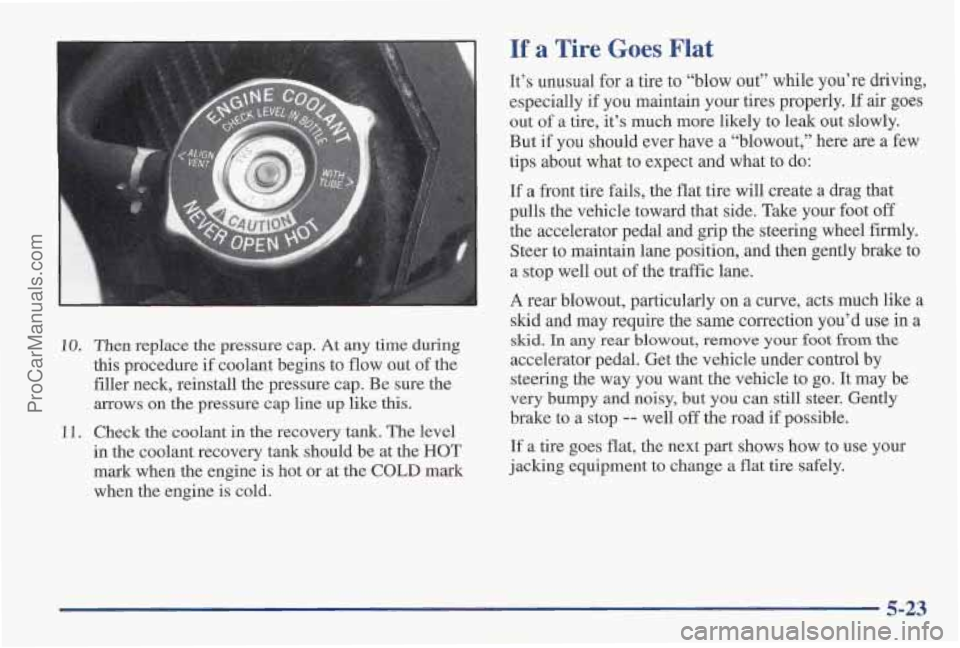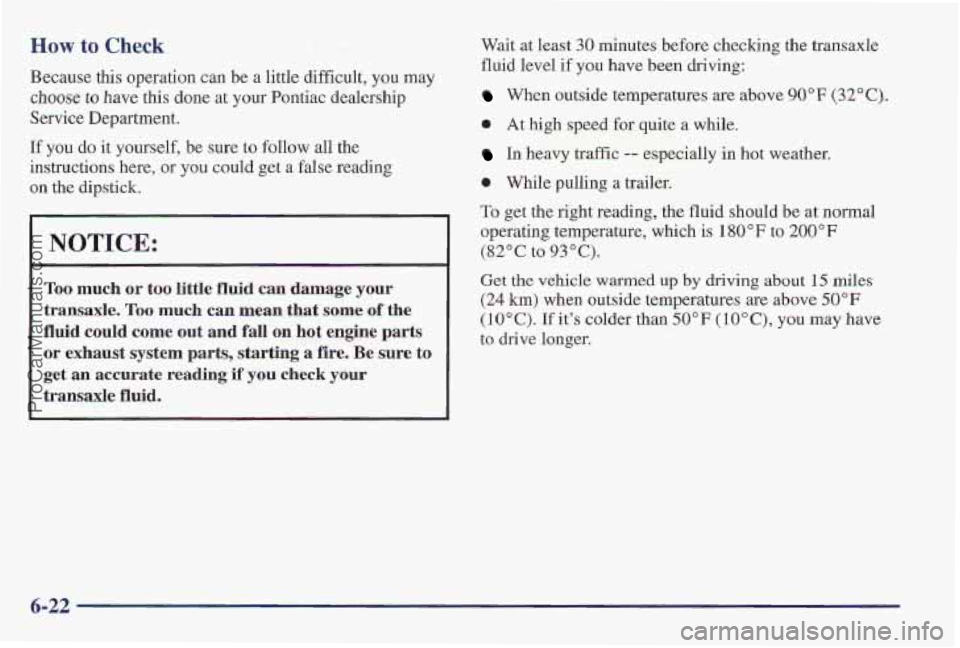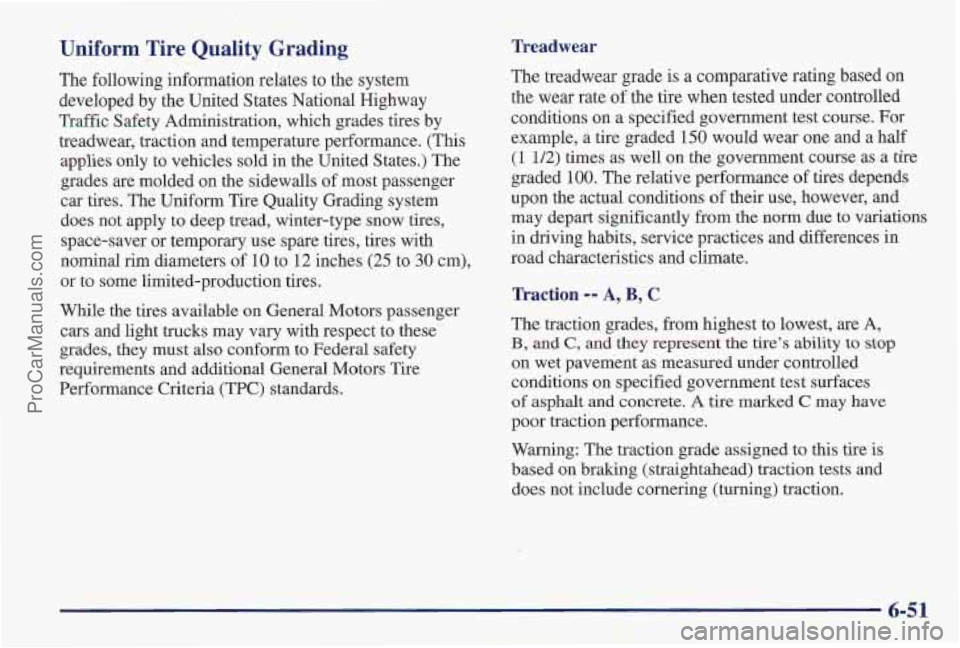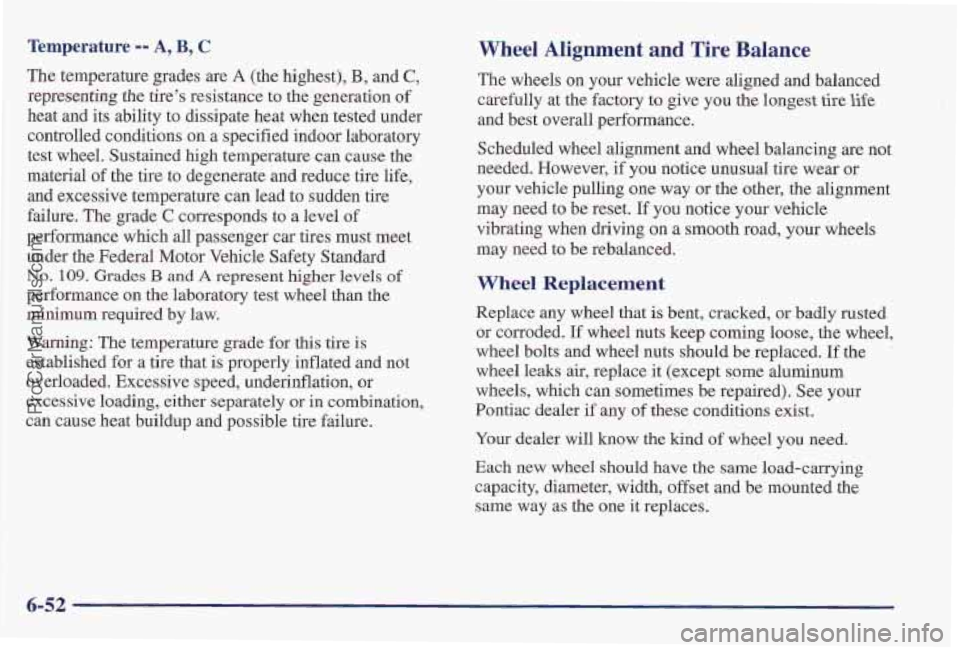1997 PONTIAC PONTIAC ESP
[x] Cancel search: ESPPage 232 of 419

Parking on Hills
You really should not park your vehicle, with a trailer
attached,
on a hill. If something goes wrong, your rig
could start to move. People
can be injured, and both
your vehicle and the trailer can be damaged.
But
if you ever have to park your rig on a hill, here’s
how to do it:
1. Apply your regular brakes, but don’t shift into
2. Have someone place chocks under the trailer wheels.
3. When the wheel chocks are in place, release the
regular brakes until the chocks absorb the load.
4. Reapply the regular brakes. Then apply your parking
brake, and then shift to
FARM (P).
5. Release the regular brakes.
PARK (P) yet,
When You Are Ready to Leave After
Parking on a Hill
1. Apply your regular brakes and hold the pedal down
while you:
Start your engine;
Shift into a gear; and
0 Release the parking brake.
2. Let up on the brake pedal.
3. Drive slowly until the trailer is clear of the chocks.
4. Stop and have someone pick up and store the chocks.
Maintenance When Trailer Towing
Your vehicle will need service more often when you’re
pulling
a trailer. See the Maintenance Schedule for more
on this. Things that are especially important in trailer
operation are automatic transaxle fluid (don’t overfill),
engine oil, belts, belt, cooling system and brake
adjustment. Each
of these is covered in this manual, and
the Index will
help you find them quickly. If you’re
trailering, it’s a good idea to review these sections
before you start your trip.
Check periodically to see that all hitch nuts and bolts
are tight.
4-38
ProCarManuals.com
Page 257 of 419

If a Tire Goes Flat
10. Then replace the pressure cap. At any time during
this procedure if coolant begins to flow out
of the
filler neck, reinstall the pressure cap. Be sure the
mows
on the pressure cap line up like this.
11. Check the coolant in the recovery tank. The level
in the coolant recovery tank should be at the HOT
mark when the engine is
hot or at the COLD mark
when the engine is cold. It’s unusual for
a tire to “blow out”
while you’re driving,
especially
if you maintain your tires properly. If air goes
out of a tire, it’s much more likely to leak out slowly.
But if you should ever have a “blowout,” here are a few
tips about what to expect and what to do:
If
a front tire fails, the flat tire will create a drag that
pulls the vehicle toward that side. Take your foot
off
the accelerator pedal and grip the steering wheel firmly.
Steer to maintain lane position, and then gently brake to
a stop well out
of the traffic lane.
A rear blowout, particularly on a curve, acts much like a
slud and may require the same correction you’d use in a
skid. In any rear blowout, remove your foot from the
accelerator pedal. Get the vehicle under control by
steering the way you want the vehicle to go. It may be
very bumpy and
noisy, but you can still steer. Gently
brake to a stop
-- well off the road if possible.
If a tire goes flat, the next part shows how to use your
jacking equipment to change a
flat tire safely.
ProCarManuals.com
Page 292 of 419

How to Check
Because this operation can be a little difficult, you may
choose to have this done at your Pontiac dealership
Service Department.
If you do it yourself, be sure to follow all the
instructions here, or you could get
a false reading
on the dipstick.
NOTICE:
Too much or too little fluid can damage your
transaxle. Too much can mean that some of the
fluid could come out and fall on hot engine parts
or exhaust
system parts, starting a fire. Be sure to
get
an accurate reading if you check your
transaxle
fluid,
Wait at least 30 minutes before checking the transaxle
fluid level if you have been driving:
When outside temperatures are above 90°F (32°C).
0 At high speed for quite a while.
In heavy traffic -- especially in hot weather.
0 While pulling a trailer.
To get the right reading, the fluid should be at norrnal
operating temperature, which is
1801°F to 200°F
(82°C to 93°C).
Get the vehicle warmed up by driving about 15 miles
(24 km) when outside temperatures are above 50°F
( lo°C). If it's colder than 50" F ( lO"C), you may have
to drive longer.
6-22
ProCarManuals.com
Page 295 of 419

How to Add Fluid
3.
4.
3800 or 3800 Supercharged Engine
Check both sides of the dipstick, and read the
lower level. The fluid level must
be in the
cross-hatched area.
If the fluid level is in the acceptable range, push the
dipstick back in
all the way. Refer
to the Maintenance Schedule to determine what
kind
of transaxle fluid to use. See “Recommended
Fluids and Lubricants” in the Index.
If the fluid level
is low, add only enough of the proper
fluid to bring the level into the cross-hatched area on
the dipstick.
1. Pull out the dipstick.
2. Using a long-neck funnel, add enough fluid at the
dipstick hole to bring it to the proper level.
It doesn’t
take much fluid, generally less than one pint
(0.5 L).
Don’t overfill. We recommend you use only fluid
labeled DEXR0N’-111, because fluid with that label
is made especially for your automatic transaxle.
Damage caused by fluid other than
DEXRON-I11 is
not covered
by your new vehicle warranty.
0 After adding fluid, recheck the fluid level as
described under
“How to Check.”
0 When the correct fluid level is obtained, push the
dipstick back in all the way.
6-25
ProCarManuals.com
Page 321 of 419

Uniform Tire Quality Grading
The following information relates to the system
developed by the United States National Highway
Traffic Safety Administration, which grades tires by
treadwear, traction and temperature performance. (This applies only to vehicles sold in the United States.) The
grades are molded on the sidewalls of most passenger
car tires. The Uniform Tire Quality Grading system
does not apply
to deep tread, winter-type snow tires,
space-saver or temporary use spare tires, tires with
nominal rim diameters
of 10 to 12 inches (25 to 30 cm),
or to some limited-production tires.
While the tires available on General Motors passenger
cars and light trucks may vary with respect to these
grades, they must also conform to Federal safety
requirements and additional General Motors Tire
Performance Criteria (TPC) standards.
Treadwear
The treadwear grade is a comparative rating based on
the
wear rate of the tire when tested under controlled
conditions on a specified government test course. For
example, a tire graded
150 would wear one and a half
(1 1/2) times as well on the government course as a tire
graded 100. The relative performance of tires depends
upon the actual conditions
of their use, however, and
may depart significantly from the norm due to variations
in driving habits, service practices and differences in
road characteristics and climate.
Traction -- A, B, C
The traction grades, from highest to lowest, are A,
B, and C, and they represent the tire's ability to stop
on wet pavement as measured under controlled
conditions on specified government test surfaces
of asphalt and concrete. A tire marked C may have
poor traction performance.
Warning: The traction grade assigned to this tire
is
based on braking (straightahead) traction tests and
does not include cornering '(turning) traction.
6-51
ProCarManuals.com
Page 322 of 419

Temperature -- A, B, C Wheel Alignment and Tire Balance
The temperature grades are A (the highest), B, and C,
representing the tire’s resistance to the generation of
heat and its ability to dissipate heat when tested under
controlled conditions
on a specified indoor laboratory
test wheel. Sustained high temperature can cause the
material
of the tire to degenerate and reduce tire life,
and excessive temperature can lead to sudden tire
failure. The grade
C corresponds to a level of
Performance which all passenger car tires must meet
under the Federal Motor Vehicle Safety Standard
No. 109. Grades B and A represent higher levels of
performance on the laboratory test wheel than the
minimum required
by law.
Warning: The temperature grade for this tire is
established for a tire that
is properly inflated and not
overloaded. Excessive speed, underinflation, or
excessive loading, either separately or in combination,
can cause heat buildup and possible tire failure. The wheels
on your vehicle were aligned and balanced
carefully at the factory to give you the longest
tire life
and best overall performance.
Scheduled wheel alignment and wheel balancing
are not
needed. However,
if you notice unusual tire wear or
your vehicle pulling
one way or the other, the alignment
may need to be reset.
If you notice your vehicle
vibrating when driving on
a smooth road, your wheels
may need to be rebalanced.
Wheel Replacement
Replace any wheel that is bent, cracked, or badly rusted
or corroded. If wheel nuts keep corning loose, the wheel,
wheel bolts and wheel nuts should
be replaced. If the
wheel leaks air, replace it (except some aluminum
wheels, which can sometimes be repaired). See your
Pontiac dealer if any of these conditions exist.
Your dealer will know
the kind of wheel you need.
Each new wheel should have the same load-carrying
capacity, diameter, width, offset and be mounted the
same way as the one it rep1,aces.
6-52
ProCarManuals.com